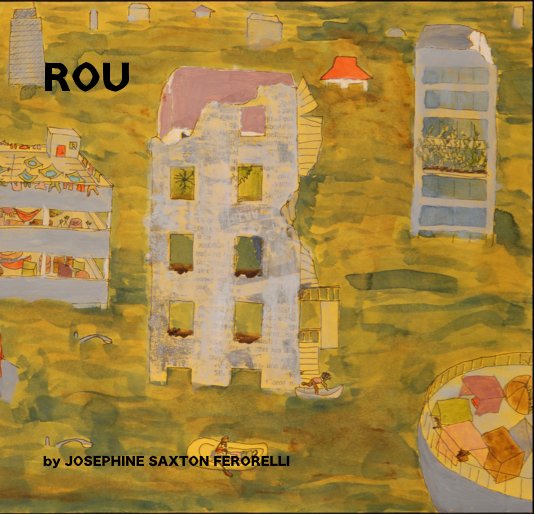About the Book
. Rou is a 57-page picture book for adolescent and adult readers. It's a day in the life of a 14 year old boy, Rou, whose wanderings take us on a tour of a city where climate change has already wrought its worst. It is a new take on the increasingly popular graphic novel that abandons the conventional panels and speech-bubbles for a more intimate visual style, more challenging prose, and an urgent political theme.
I made Rou with a feeling of personal urgency; at 26 years old, I’ve lived my whole life with the specter of global warming, and my generation will certainly spend the rest of our lives reckoning with its consequences. It feels overwhelmingly important to talk about that future not just as a dire warning but as a real part of life. This manuscript is the result of a two-year-long thought-experiment I've called ‘The Lighter Side of Climate Change’. I've been trying to imagine scenarios where good things like love and humor continue to exist even when there's no earthly reason for them to.
The story begins as Rou and Tio find a place to live, or “stole a casita,” in the jangly Indo-European patois they and their fellow citizens speak. It improvises on and collapses Spanish, French, Italian, Hindi and an English that no longer has use for the verb 'to have,' the legacy of mass migrations and a near-total lack of material possessions. Tio is a man who is too old and feeble to care for himself. Young Rou keeps them both alive by fishing and trading from his canoe in the ruins of their waterlogged city, but it’s a heavy burden for a boy. Rou feeds and cares for Tio, as Tio once did the same for him, and so life continues in the face of a worst-case-scenario.
The images are mixed-media, mostly tempera, watercolor and ink, all on construction paper. Each page is vividly colored and full of odd detail; I want them to absorb the viewer the way I remember being captured by pages from certain children’s books and issues of National Geographic when I was little. Rou may be a grim vision, but it’s also panoramic. I imagine it appealing to graphic novel readers, but also to people who find the cramped and colorless images of most comics off-putting. Although the language is unusual, it’s concise and illustrated clearly enough that it’s unlikely to put off any but the youngest readers. It could exist as easily in an online format as on bookshelves. In short, it’s a project that wants the world to see it.
I made Rou with a feeling of personal urgency; at 26 years old, I’ve lived my whole life with the specter of global warming, and my generation will certainly spend the rest of our lives reckoning with its consequences. It feels overwhelmingly important to talk about that future not just as a dire warning but as a real part of life. This manuscript is the result of a two-year-long thought-experiment I've called ‘The Lighter Side of Climate Change’. I've been trying to imagine scenarios where good things like love and humor continue to exist even when there's no earthly reason for them to.
The story begins as Rou and Tio find a place to live, or “stole a casita,” in the jangly Indo-European patois they and their fellow citizens speak. It improvises on and collapses Spanish, French, Italian, Hindi and an English that no longer has use for the verb 'to have,' the legacy of mass migrations and a near-total lack of material possessions. Tio is a man who is too old and feeble to care for himself. Young Rou keeps them both alive by fishing and trading from his canoe in the ruins of their waterlogged city, but it’s a heavy burden for a boy. Rou feeds and cares for Tio, as Tio once did the same for him, and so life continues in the face of a worst-case-scenario.
The images are mixed-media, mostly tempera, watercolor and ink, all on construction paper. Each page is vividly colored and full of odd detail; I want them to absorb the viewer the way I remember being captured by pages from certain children’s books and issues of National Geographic when I was little. Rou may be a grim vision, but it’s also panoramic. I imagine it appealing to graphic novel readers, but also to people who find the cramped and colorless images of most comics off-putting. Although the language is unusual, it’s concise and illustrated clearly enough that it’s unlikely to put off any but the youngest readers. It could exist as easily in an online format as on bookshelves. In short, it’s a project that wants the world to see it.
Features & Details
- Primary Category: Comics & Graphic Novels
-
Project Option: Small Square, 7×7 in, 18×18 cm
# of Pages: 64 - Publish Date: Jun 24, 2009
- Keywords graphic novel, adventure, flood, future, illustrated, fiction, coming-of-age
See More


